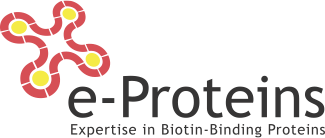Isoelectic point customization
You are here :
- Home
- R&D program
- Isoelectic point customization
Tailoring pI for a Non-Specific Interactions reduction
Addressing the challenge of non-specific interactions reduction through adapted isoelectric point (pI) modification constitutes a significant topic in biochemistry. Researchers often prefer Neutralite Avidin, with a pI of 6.3, over standard avidin (pI of 10) for certain biochemical applications. This preference arises from the influence of the protein’s charge on its interactions in a physiological pH environment, which typically ranges between 6.5 and 7.5.
Protein Charge and Non-Specific Interactions:
At physiological pH, standard avidin, with a pI of 10, assumes a positive charge. This high positive charge increases the likelihood of non-specific interactions with negatively charged molecules or structures such as cell membranes or certain biological molecules. Conversely, Neutralite Avidin, with a pI of 6.3, nearly attains neutrality or a slight charge in a physiological environment. This leads to a reduction in non-specific interactions due to electrostatic attractions.
Adaptation to Physiological pH:
Neutralite Avidin aligns better with the physiological pH of biological systems. At a pH close to its pI, it presents a minimal net charge, thus reducing non-specific interactions that could interfere with the protein’s performance in specific applications.
Applications Sensitive to non-specific Interactions:
In applications like immunohistochemistry, ELISA, or flow cytometry, where precision and specificity are paramount, the reduction of non-specific interactions becomes essential for accurate results. Therefore, researchers often prefer Neutralite Avidin due to its pI closer to neutrality.
Protein Stability and Functionality:
While pI plays an important role, other aspects of the protein’s structure and function hold significance. Neutralite Avidin retains a strong affinity for biotin while optimizing non-specific interactions reduction , offering a major advantage for numerous biochemical and biomedical applications.
Regarding Streptavidin:
Despite relatively close pI values between Neutralite Avidin and Streptavidin, slight differences between them can significantly impact their utility in specific applications. Researchers often prefer Neutralite Avidin to minimize non-specific interactions, whereas Streptavidin is chosen for its strong affinity for biotin and its slightly lower charge at physiological pH.
In conclusion
The pI of Neutralite Avidin, closer to neutrality compared to standard avidin, renders it more suitable for applications where the reduction of non-specific interactions proves beneficial.
The Interest in Modulating pI
The isoelectric point (pI) of a protein represents the pH at which the protein attains a net zero charge. Below its pI, a protein assumes a positive charge, while above it, it becomes negatively charged. This phenomenon affects non-specific interactions.
Reducing Non-Specific Interactions with Negatively Charged Molecules or Structures:
If a protein possesses a high pI, such as standard avidin with a pI of approximately 10, it tends to become positively charged in most biological environments, where the pH typically falls between 6.5 and 7.5. This increases non-specific interactions with negatively charged structures or molecules, such as cell membranes, nucleic acids, and modified proteins.
Lowering pI and Reducing Non-Specific Interactions:
Lowering a protein’s pI, for example, by approaching neutrality (similar to Neutralite Avidin’s pI of about 6.3), diminishes its positive charge at physiological pH. Consequently, this decreases non-specific interactions with negatively charged molecules or structures.
Optimizing pI for Specific Applications:
The objective is to optimize the pI to improve the non-specific interactions reduction while preserving the specific and functional interactions necessary for a given application. However, lowering the pI excessively could potentially diminish or alter important specific interactions crucial for the protein’s function.
Balancing Charge and non-specific Interaction reduction :
Finding a balance between reducing non-specific interactions and maintaining functionality remains critical. For some proteins, an excessively low pI could also result in increased non-specific interactions with positively charged molecules.
For various applications, the isoelectric point can be customized in the following products to optimize their functionality within specific ranges:
- Avidin —> Neutralized avidin with pI values ranging from 5.5 to 10
- Deglycosylated avidin —> Neutralite avidin with pI values ranging from 5.5 to 10
- Oligomerized (Poly-) avidin —> Ultracoat50 and Ultracoat70 with pI values ranging from 5.5 to 10
In summary, lowering a protein’s pI can improve non-specific interactions reduction with negatively charged molecules or structures, but this must be balanced with maintaining its specific interactions and overall structural stability.
Technical Challenge in Decreasing Isoelectric Point:
Modifying the isoelectric point (pI) of a protein like Neutralite Avidin to lower it to 5 would involve altering its chemical structure, potentially affecting its binding properties and other functional characteristics. Here are some technical aspects to consider during modification:
Stability of Biotin-Avidin Binding:
Neutralite Avidin was designed to maintain a strong affinity for biotin while reducing non-specific binding. Care must be taken to ensure that affinity remains unaffected by the change in isoelectric point.
Effects on Structure and Function:
A protein’s three-dimensional structure governs its function. Modifying the pI can lead to structural changes that influence the protein’s ability to bind biotin or other molecules. Therefore, thorough testing of its binding capacity after the process is crucial.
Protein-Protein and Protein-Ligand Interactions:
Interactions between proteins and their ligands or other proteins often hinge on charge and charge distribution. A significant pI change can disrupt these interactions. Depending on the application, the use of these ligands may not be necessary, allowing for a reduction in the isoelectric point without altering the protein’s function in the targeted application.
Protein Modification Techniques for a efficient non-specific interactions reduction
Modifying a protein’s pI is a complex task, requiring precise and delicate chemical modifications. These techniques can be intricate and do not always guarantee the desired outcome. Adjusting the points of stable and robust functioning is key to consistently achieving the desired specifications, batch after batch.
In conclusion
Before embarking on any modification of the pI beyond the reference values, it is essential to evaluate the benefits in terms of functionality and the impact of reducing non-specific interactions for the intended application. The research and development required to create a variant with a modified pI entail both time and resources.
